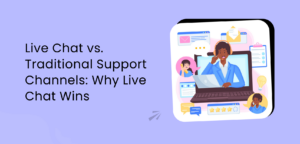
Damilola Oyetunji
Content Writer at Chatway.
Quickly respond to customer and visitor inquiries via live chat
Personalize the chat widget to match your business's style and branding
Stay updated on all incoming messages with email and push notifications
Improve the way your team works with chat assignments and private notes
Provide support on the go with Chatway's mobile apps for iOS and Android devices
Categorize and label conversations using specific criteria for personalized support
Interact with visitors in their preferred language, supporting 20+ languages
Use Chatway live chat on multiple platforms such as Shopify, Wix, Duda etc
Get insights into your support activities to better understand customer interactions
Centralize chats from Messenger and email into a single dashboard
All,Customer Service,Marketing,Support - 6 Mins READ
Content Marketer

No matter what business growth stage your company is at, whether seed, startup, growth, or maturity, understanding your customers is key to providing the best service possible.
When you know how your customers think, what motivates them, and what their preferences are, you can tailor your products or services to meet their needs and expectations. You can also improve your marketing strategies, refine your business strategy and position yourself for success. You’ll know what kind of messaging and advertising appeals to them, which channels they prefer to use, and what kind of content they engage with. This information can help you create targeted campaigns that resonate with your customers and drive more sales.
In addition, understanding your customers’ behaviour can help you identify areas for improvement in your products or services. If you know what frustrates or dissatisfies your customers, you can work to address those issues and make changes that will keep them coming back.
To provide excellent customer service, you must first understand what your customers want and need. Customer behaviour can help you identify these things and create effective strategies to meet them.
So, how do you understand your customer’s behaviour? In this piece, we’ll show you how.
One of the easiest ways to learn about your customer’s behaviour is to conduct surveys and questionnaires. These tools can help you gather specific data about your customers’ preferences, needs, and expectations. You can use online surveys and questionnaires, which are easy to administer and provide quick feedback.
Before creating your survey or questionnaire, you should have a clear understanding of what you want to achieve. Define the purpose of your research, the questions you want to answer, and the audience you want to target. Make sure your questions are clear, concise, and relevant to your research goals.
Avoid leading questions or questions that are too complicated. For example, instead of asking “Do you like our product?” ask “What do you like about our product?”
Distribute your survey or questionnaire through various channels, such as email, social media, or your website. Once you’ve collected your responses, analyze the data to identify patterns and trends. Look for common themes in the responses and use this information to improve your products, services, or customer experience.

Analyzing customer feedback can provide valuable insights into your customer’s behaviour. It helps you identify recurring issues and address them promptly. It also enables you to identify opportunities to improve your service delivery, which can lead to increased customer loyalty.
Once you have collected the data, you’ll need to organize and categorize it in a way that is easy to understand and analyze.
One popular method for analyzing customer data is through data visualization tools such as graphs, charts, and tables. These tools can help you identify patterns and trends in customer behaviour, such as which products are most popular, how often customers make purchases, and what times of day customers are most active.
For example, let’s say you run an online clothing store. By analyzing customer data, you might discover that a particular product category is selling particularly well in the summer months, while sales for another category increase during the winter months. This information can help you plan your inventory and marketing funnel strategies accordingly.
Another way to analyze customer data is through segmentation. This can help you identify unique needs and preferences for each group and create targeted marketing campaigns.
Social media is a great tool for learning about your customer’s behaviour. Monitoring social media activity can help you identify trends, concerns, and feedback in real-time. You can use this information to develop effective strategies to meet your customer’s needs.
First, identify which social media platforms your customers are most active on. For example, if you run a fashion brand, you may find that Instagram is the best platform to monitor. If you run a B2B business, LinkedIn may be more appropriate.
Next, you can start using social media monitoring tools like Hoosuite or Mention to keep an eye on what your customers are saying. There are many tools available, both free and paid, that allow you to track mentions of your brand, product or industry keywords, and even your competitors.

Tracking your website can help you understand how your customers are using your products and services. It can provide insights into how customers navigate your website and where they encounter problems.
To track website usage and understand customers’ behaviour, there are a few steps you can follow.
This information can help you make necessary improvements to your website to enhance the customer experience.
Creating customer personas involves developing fictional characters that represent your customer segments. You can identify the problems they are trying to solve with your product or service.
For example, if you sell software for small businesses, one of your customer personas might be a busy entrepreneur who struggles to keep track of finances. By understanding their pain points, you can develop features that simplify financial management and make their life easier.
This can help you tailor your messaging and product features to better meet their needs. Also, knowing your customer’s preferences and habits can help you create a better user experience.
It can also help you create targeted marketing messages that resonate with your audience.

Conducting market research can provide valuable insights into your customer’s behavior. It enables you to identify trends, opportunities, and threats in your industry.
Before you start your research, it’s essential to define your objectives. What questions do you want to answer? What information do you need to collect? Knowing what you want to achieve will help you focus your research efforts and make the most of your time and resources.
Let’s say you want to launch a new line of organic skincare products. Your research objective might be to understand customers’ attitudes towards natural products and what factors influence their purchasing decisions.
You can use this information to develop effective strategies that meet your customer’s needs and expectations
While not a direct strategy for understanding customer behaviour, training your employees on customer behaviour can help them understand your customers’ needs and expectations.
They interact with your customers on a regular basis and have more opportunities to spot patterns and trends in behaviour. It’s necessary to educate and train your employees to analyse these patterns from their daily interactions with customers. This can elevate their experience and also help them develop the skills necessary to provide exceptional customer service.
Customer behaviour is constantly evolving, so it’s important to continuously update your strategies. Regularly reviewing and updating your strategies can help you stay ahead of your competitors and provide exceptional customer service. It can also help you identify new opportunities to improve your service delivery and increase customer satisfaction.
Lastly, measuring the effectiveness of your strategies is critical to improving your service delivery. It enables you to identify areas that need improvement and areas where you’re excelling. You can use this information to adjust your strategies and provide better service to your customers.
Engaging with your customers directly can provide valuable insights into their behaviour. It enables you to build strong relationships with them and understand their needs and expectations. You can use the strategies shared in this article to develop effective business and marketing strategies that meet their needs and exceed their expectations.

Content Writer at Chatway.

Content Writer at Chatway.

Content Writer at Chatway.